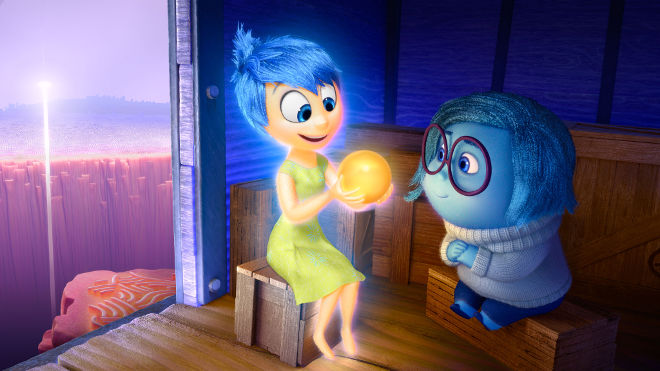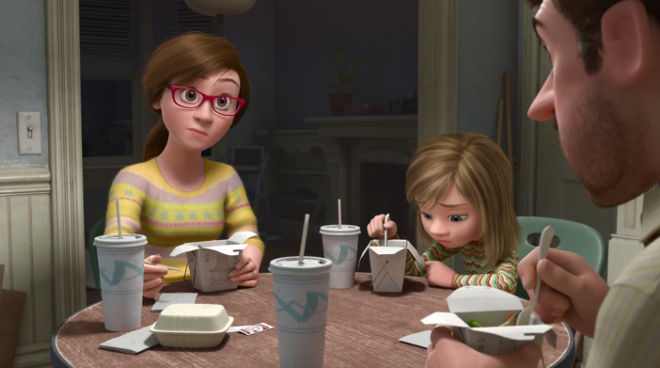The Great Depression: ‘Inside Out’ Is Funny, Bittersweet, And One Of Pixar’s Finest Films
How do you even begin to review a film that, at its best moments, catapults you into the same realm of catharsis you last experienced during two years on the analyst’s couch?

Here’s the problem I have with Inside Out, Pete Docter and co-director Ronnie del Carmen’s astounding new addition to the venerable Pixar canon: how do you even begin to review a film that, at its best moments, catapults you into the same realm of catharsis you last experienced during two years on the analyst’s couch?
I was so gripped by Inside Out when I attended the media screening that my mind (pens with lights in them are for assholes) could commit nothing to memory beyond images that would bring on a strange mix of laughter and near-apoplectic weeping. So I bought a ticket to an advance screening and, along with a few hundred pre-teens, watched the film anew.
The second time around, I laughed less (though increasingly deeply), and cried more, and finally decided that Inside Out is, along with Lars Von Trier’s Melancholia, one of the most nuanced and elegant filmic depictions of depression I have ever seen. It’s also, for my money, one of Pixar’s finest films, if not their best.
Do You Ever Look At Someone And Wonder, ‘What Is Going On Inside Their Head?’
Pixar have always worked within an emotional realm, so in a way it makes sense that they have finally decided to explore the emotional realm.
Inside Out’s premise is at once childlike and incredibly complex: as she grows up, we meet the emotions who live in a little girl’s head. “Headquarters”, it turns out, is staffed by Joy (Amy Poehler), who is present at both the birth of Riley (Kaitlyn Dias), and the birth of Riley’s human consciousness. Before long she’s joined by Sadness (Phyllis Smith), then Anger (Lewis Black), Fear (Bill Hader) and Disgust (Mindy Kaling). They’re curious little creatures comprised of glowing particles, which makes them look like jubes who’ve been rolled in fairy dust.
From their Fisher Price-esque command module they fire off Riley’s emotional responses, which in turn create memories: glowing, oversized marbles that are shuffled off to Long Term Memory at the end of each day while she sleeps. Her “Core Memories”, all joy-filled, are what power her Islands Of Personality: her love of ice hockey, friendship, being a “goofball”, her honesty, and her loving family. Riley is 11-years-old and loves her life.
That is, until the family move from Minnesota to San Francisco: Riley’s dad (Kyle MacLachlan) has a new job in tech (signified by stressed-out phone conversations about “capital”), so he, mom (Diane Lane) and Riley drive cross-country to their new home and lives.
It’s here that things start going awry in Headquarters: Sadness accidentally touches a Core Memory, and Riley is gripped by a melancholy that overtakes her first day at a new school; to Fear’s horror, “WE’RE CRYING IN SCHOOL!!”, while Disgust notes that the “cool girls” are whispering. Furious at Sadness’ meddling (well, as furious as the embodiment of pure joy can be), Joy tries to send the now-tainted Core Memory to Long Term, but she and Sadness — and all the Core Memories — are sucked up like a message in a pneumatic tube, and whisked away from Headquarters.
With only Fear, Anger and Disgust left to do the “driving”, Joy and Sadness battle to return to Headquarters or risk Riley’s personality forever disappearing into the Memory Dump along with all those things (piano lessons, phone numbers) she doesn’t need to remember.
Strap in, guys, it only gets more complex from there.
Deeper And Deeper
It’s once Joy and Sadness travel to Long Term Memory that Inside Out really picks up steam. The film explores, in a visually stunning sequence, the various stages of abstract thought (“Oh no, we’re deconstructing!”) and the complexities of memory (with one hilarious recurring gag about the stuff you remember forever, even if you don’t want to); there’s even a trip to the subconscious (“It’s where they take all the troublemakers”; somewhere, Sigmund Freud is LOLing).
Inside Out is remarkable in the originality of both its concept and its execution. There’s something glorious in the way these mind-bending concepts of consciousness provide so much joke fodder. What’s more, it’s all explored with the avant garde panache of an early Disney short, or some of Fantasia’s more abstract moments; in a way, it’s the most successful blending yet of the “Pixar” and “Disney” worlds.
Where previous Pixar movies have jammed in the pop culture references thick and fast, Inside Out is almost completely stripped of them, so the few that remain — a Chinatown gag, a visual nod to Contact’s intergalactic wormholes, a jellybean-like voice actor in Dream Productions who looks like voice superstar John DiMaggio — really hit home. But it’s the brain-related gags that take your breath away; in one, Joy knocks over some boxes of Facts and Opinions and laments, while trying to tidy them up, that “[they] look so similar!”
Long Term Memory is also where Joy and Sadness meet Bing Bong, Riley’s imaginary friend, exquisitely played by Richard Kind with a mix of winningly ineffectual Looney Tunes bravado, and a deeper, darker quality that recalls Ray Bolger’s melancholy Scarecrow. He acts initially as Joy and Sadness’ happy-go-lucky guide before his own arc blossoms in an entirely unexpected and profoundly resonant way. In the pantheon of voice acting, Kind’s performance deserves to be remembered as one of the greats.
Similarly, Poehler and Smith bring Joy and Sadness to life with great care; they (and their cohorts) may be the physical representations of single emotions, but they experience — and, thus, so do we — the full spectrum. Hell, the whole cast is great; even Flea does a great job.
Deceptively Simple, Mind-Bendingly Complex
A superficial reading of Inside Out might find its characterisations — particularly the people themselves — a bit old hat: Dad’s Headquarters is distracted while thinking about sports; Mom’s fantasise about that “Brazilian helicopter pilot” she could have married; Riley hates broccoli and is scared of clowns. Stripped of their context, they may feel like obvious choices.
But I think the film works well precisely because these simple choices — there’s an argument here for Jungian archetypes, if you want to get funky — allow the complexities of the film’s philosophical landscape to grow in stature as the story progresses. Would the film’s exploration of the human condition have been so arresting had Riley’s phobias been hyper-specific, or Dad been a Proud Male Feminist, or Sadness not been a little blue blob?
(I also find it fascinating, and not much touched on by critics, that the spirited stay-at-home Mom’s Headquarters is in fact commanded by Sadness, not Joy. Did she give up a career in tech along with that Brazilian helicopter pilot?)
What’s It All About, Riley?
Exactly what Inside Out is about will be a cause for debate: the obvious choice is “adolescence”; a darker choice interprets the film as questioning the notion of free will. From where I sit, the film is a parable about depression.
As her “Islands of Personality” disintegrate, Riley becomes husk-like, drifting through her new life in a fog of confusion. In his essay, Mourning And Melancholia (and beyond), Freud explored the notion of anger turned inward and its role in depression; Riley’s decision to flee is marshalled, courtesy of a literal lightbulb moment, by Anger.
While popular opinion might still consider depression to be a state of extreme sadness (and PSAs featuring people weeping while doing the dishes aid that misconception), it is far more complex than that. In Riley’s descent, fuelled by Anger, Fear and Disgust — and most importantly the absence of Joy and Sadness — I saw a crystal clear illustration of what depression feels like.
But as we all know, film theory is a free-for-all, and much as I once sniffed at somebody arguing that Edward Scissorhands was a Western, someone else may hoot at my reading of Inside Out as allegory for depression.
Anyway, emotions are not moods (or mood disorders); the filmmakers worked with psychologist Paul Ekman to finesse the movie’s exploration of emotion. And so, maybe more importantly, the film really brings home the idea of a normative, un-pathologised sadness: in Joy and Sadness’ learning the latter’s important role, it sends a very healthful message to the viewer. It’s like Rosey Grier’s ‘It’s Alright To Cry‘, from 1972’s seminal Free To Be… You And Me, has taken flight and evolved into something even more profound. Similarly, Joy’s teetering on the brink of being grating is a delicate comment on the unhelpfulness of pursuing Happiness™ at the expense of deeper engagement with oneself and the world.
In this way, I think Inside Out is an enormously important film. I am loath to use the term ~teachable~, but I don’t think it’s an overreaction to imagine the film’s delicate exploration of emotion and the intricacies of the mind ending up on a school syllabus of the future.
What an extraordinarily humane thing Docter, del Carmen and their colleagues have done for the children — and former children — of the world. Inside Out is a masterpiece.
–
Inside Out is released around Australia today.
–
Clem Bastow is an award-winning writer and critic with a focus on popular culture, gender politics, mental health, and weird internet humour. She’s on Twitter at @clembastow

